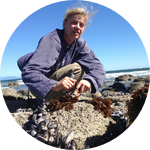About This Project
Recently, a devastating epidemic called "sea star wasting disease" (SSWD) has killed huge numbers of sea stars on the west coast of North America. One common and ecologically important species (Pisaster ochraceus) has a mutation that seems to protect carriers. Here, I will use high-throughput RNA sequencing to identify how that mutation alters the tissue and cellular composition of sea stars. These data will be key in predicting how Pisaster will recover from this disease outbreak.
Ask the Scientists
Join The DiscussionWhat is the context of this research?
In recent years, many species of sea stars on the west coast of North America have been dying rapidly. The epidemic is called "sea star wasting disease" and affects over 20 species, some of them with nearly complete mortality. Several research groups are exploring the ecological and evolutionary consequences of this mass mortality event. My own work has shown that there is a mutation in Pisaster ochraceus, a common and ecologically important species, that partially protects individuals that carry the mutation. As sea stars are predators that have massive influence on the diversity of intertidal ecosystems, we need to understand quickly what this disease is, and what the potential is for species to survive the epidemic.
What is the significance of this project?
It is unusual to find a mutation that protects individuals from disease; the best example that you have probably heard about is a mutation that affects the hemoglobin protein in humans. Individuals with 2 copies of this mutation have sickle-cell disease with high mortality and terrible symptoms, but if they have 1 copy they are relatively healthy and are partially protected from malaria!
That is roughly how this mutation works in Pisaster ochraceus. Individuals with 2 copies do not survive, and individuals with 1 copy have lower mortality to SSWD. This project will help us understand the specific mechanisms that protect carriers, and the general ways in which this informs animal and human health when the environment changes in stressful ways.
What are the goals of the project?
Within 6 months of this project being funded, we will have 10 additional individuals of Pisaster ochraceus sequenced for their RNA composition. This includes 5 carriers, and 5 individuals without the mutation. These new data will double our current data set, which already shows very intriguing results about how some cytoskeletal proteins and proteins involved in the assembly of other proteins may be affected by this mutation. However, to ensure our answer is solid we need this additional sample of 10 individuals. The sequencing will produce over 20 million short RNA sequences from each individual; those data will be computationally compared to a reference of all known genes in Pisaster to determine which genes are expressed at different levels between the two types.
Budget
I have already collected data from 10 individual sea stars using the methods budgeted above. The current results are very compelling, but suggest that a larger sample size of individual sea stars is needed to ensure a solid answer that will guide future research. The above budget uses the same equipment and facility that was used for previous data collection.
What happens is that specially-preserved tissues in my freezer will be treated to isolate the RNA - which gives us insight into what genes are "on" and at what level - from those sea stars. Each sea star is then sequenced, obtaining ~20 million short RNA sequences. These are then computationally matched to an assembled reference library of genes and gene fragments to indicate how each individual varies in RNA expression.
Our goal is to compare individuals that carry the mutation, and individuals that do not, to find out what they do that is different that seems to protect them from the SSWD pathogen.
Endorsed by
Meet the Team
Affiliates
Team Bio
We are working on this as a faculty-student team. Wares and Chandler met during a 2015 "First Year Odyssey" course at UGA on the interplay between biology and pop culture monsters - from Godzilla to zombies. Wares has been working on marine invertebrate genetic diversity his entire career; Chandler is a sophomore double major who is a very quick study on RNA sequencing and the evolutionary ecology of disease.
John Wares
I went to graduate school to study salamanders, and somehow got turned onto the path of marine diversity. I try to understand how diversity at all scales moves and interacts, usually in coastal ecosystems but also southeastern U.S. rivers and streams. More and more frequently, the diversity we study includes parasites and pathogens. Human activity moves such organisms around the planet and gives them new contexts for interaction, and increasing ocean temperatures often causes dramatic outbreaks. Understanding the ways that marine diversity is maintained and distributed is a primary goal of my research.
Virginia Katelyn Chandler
I am a sophomore at the University of Georgia majoring in Genetics and Biochemistry & Molecular Biology. In the past year I have begun researching Sea Star Wasting Disease in ochre sea stars, and hope to continue pursuing research on the interactions of RNA expression, protein variation, and phenotype well beyond this current project.
Additional Information
If you are interested to know more about Pisaster, a great place to start is the National Geographic article published a year ago on this outbreak and the work of many of my colleagues in trying to understand it. I started working on this current project while teaching students at the Friday Harbor Laboratories in the San Juan Islands, Washington, USA. Many people - coastal residents as well as marine scientists - are very keen to know what is causing this disease, and what the prospects are for recovery. Thank you for considering this project.
The video was taken by Julia Wallace, a UW graduate student, in 2016.
Project Backers
- 23Backers
- 31%Funded
- $950Total Donations
- $41.30Average Donation



